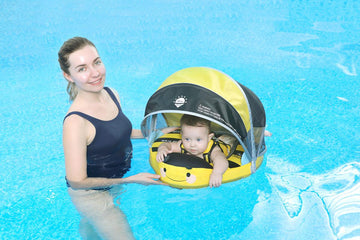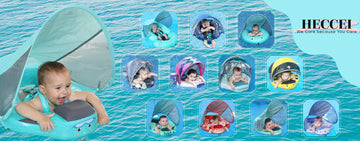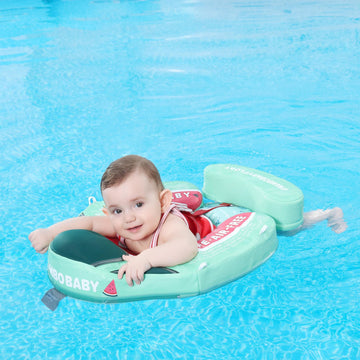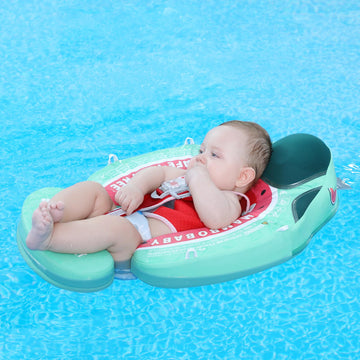
A little preparation can go a long way when it comes to children and water play. Follow these year-round tips for kids’ swimming.
Is it OK for your diaper-clad toddler to splash in the local pool? Can your child safely wear a cast or ear tubes in the water? Could bacteria lurking in the pool or lake make your little one sick?
Before you help your child suit up, consider these practical tips from Jay L. Hoecker, M.D., an emeritus pediatrics specialist at Mayo Clinic in Rochester, Minnesota.
Can babies or toddlers wear diapers in the water?
Swim diapers and swim pants are water-repellent and fit snugly around a child’s thighs and waist, but they’re not waterproof. If your child has a bowel movement in the water, fecal material might escape the diaper.
A dirty diaper might contain diarrhea-causing germs, including the parasite cryptosporidium — which can contaminate pool water or other swimming areas. In otherwise healthy people, a cryptosporidium infection causes diarrhea. The consequences can be more severe for people who have weak immune systems.
Urine in the water is less risky than feces, but it’s difficult to separate the two when children wear diapers. If you allow your child to swim in a diaper, take breaks to change the diaper in the bathroom or use the toilet. Don’t allow swimming if your child has diarrhea.
Is it risky for children to swallow pool water?
Your child is bound to gulp pool water at one time or another, especially when first learning to swim. A little swallowed pool water isn’t typically a cause for concern, but too much pool water can lead to illness. Encourage your child to spit out any water that gets in his or her mouth.
Can children who have casts go swimming?
It depends on the type of cast:
· Plaster cast. If your child has a plaster cast over cloth wrapping, he or she must stay out of the water. Trying to protect a plaster cast with plastic bags generally isn’t effective.
· Fiberglass cast. If your child has a fiberglass cast that’s lined with a water-repellent liner, it’s usually OK to swim — as long as you have the doctor’s OK. After swimming, it’s important to thoroughly rinse the inside of the cast with clean water. Generally, you can allow the cast to air-dry.
Can children swim if they have ear tubes?
If your child has ear tubes — tiny cylinders placed through the eardrum to drain fluid and allow air into the middle ear — ask his or her doctor about ear protection during swimming. Some doctors recommend that children who have ear tubes wear earplugs while swimming to prevent bacteria from entering the middle ear. However, routine use of earplugs might only be needed when children dive or swim in untreated water, such as lakes and rivers.
What’s the best way to prevent swimmer’s ear?
Swimmer’s ear is an infection that’s often treated with prescription eardrops. To prevent swimmer’s ear:
· Keep ears dry. Encourage your child to wear earplugs while swimming. After swimming, dry your child’s ears by wiping the outer ears gently with a soft towel or use a hair dryer. Put the hair dryer on the lowest setting and hold it at least a foot (about 30 centimeters) away from the ear.
· At-home preventive treatment. If your child doesn’t have punctured eardrums, use homemade preventive eardrops before and after swimming. A mixture of 1 part white vinegar to 1 part rubbing alcohol might help promote drying and prevent the growth of bacteria and fungi that can cause swimmer’s ear. Pour 1 teaspoon (about 5 milliliters) of the solution into each ear and let it drain back out. Similar over-the-counter solutions might be available at your drugstore.
· Avoid putting foreign objects in your child’s ear. Don’t use cotton swabs in your child’s ears, which can pack material deeper into the ear canal, irritate the thin skin inside the ear or break the skin.
What about red eyes after swimming?
Exposure to chlorine might leave your child with red eyes. To ease discomfort and reduce redness after swimming, rinse your child’s eyes with a sterile eyewash or an artificial tears solution. To prevent red or puffy eyes, encourage your child to wear goggles while swimming.
What’s the best age to begin swimming lessons?
Many kids learn to ride a bike and to swim on their own at the same age — often the summer before kindergarten. The American Academy of Pediatrics supports swimming lessons for most children age 4 and older.
If you enroll a child younger than age 4 in a swimming program, pick one that requires parental involvement, has qualified teachers and a fun atmosphere, and involves a limited number of underwater submersions. This will limit the amount of water your child might swallow.
Can children swim when they’re sick or have cuts and scrapes?
It’s fine for children who have colds or other minor illnesses to swim, as long as they feel well enough to do so. Likewise, it’s OK for children to swim with cuts and scrapes — as long as the wounds aren’t bleeding.
Is it OK to swim right after eating?
It’s OK to swim immediately after a light meal or snack. If your child feels lethargic after eating a heavy meal, however, encourage him or her to take a break before swimming.
Are hot tubs safe for children?
Young children can quickly become overheated in a hot tub or spa. The Centers for Disease Control (CDC) do not recommend children under 5 years use a hot tub or spa. If you allow your child to use a hot tub or spa, keep the visit supervised and brief, and don’t allow your child to put his or her head underwater. Long hair can get caught in an uncovered hot tub grate and cause drowning.




